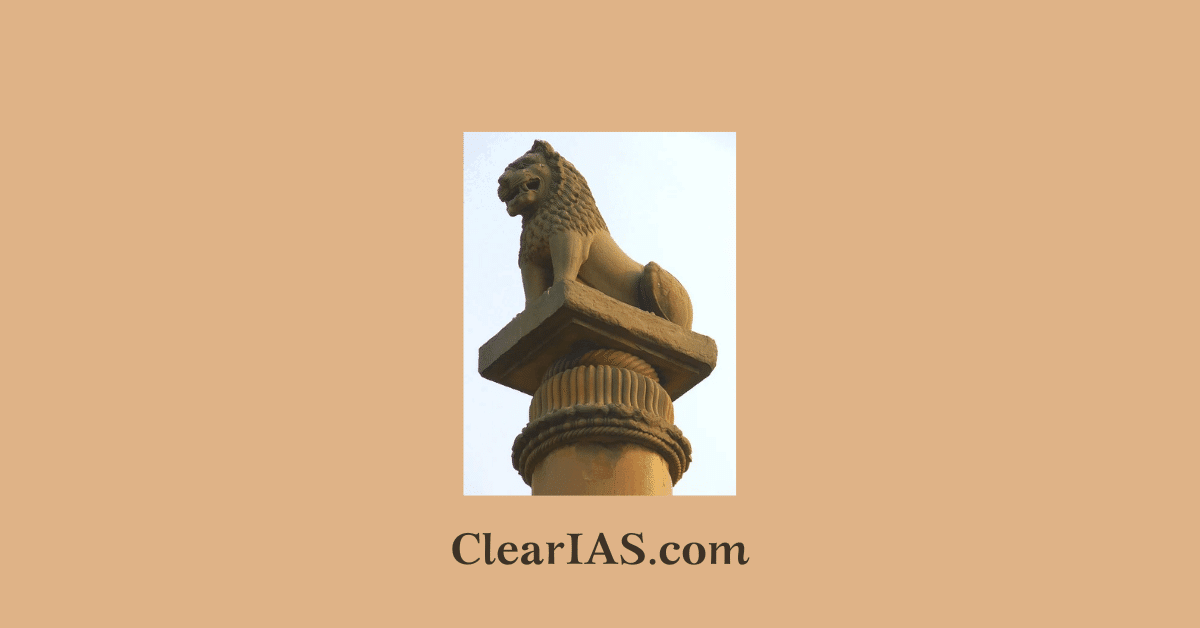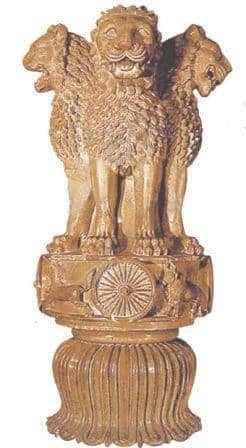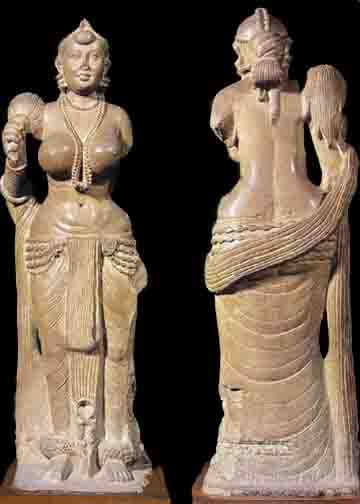
The Mauryan Empire, which existed from around 322 BCE to 185 BCE, was one of the most significant and influential empires in ancient India.
In this post, we bring you the important aspects of the arts of the Mauryan Period. The Mauryan period represents the third major period in Indian cultural history after the prehistoric times and the Indus Valley period.
The compilation is based on the NCERT textbook ‘An Introduction to Indian Art’ – Part 1. Most of the information here is presented in a bullet-point format. We hope this initiative may help aspirants to learn and revise faster.
Arts of Mauryan Period
- The sixth century BCE marks the beginning of new religious and social movements in the Gangetic Valley in the form of Buddhism and Jainism (Sramana/Shraman Tradition).
- Magadha emerged as a powerful kingdom and consolidated its control over the other religions.
- By the third century, a large part of India was under Maurya control.
- Ashoka emerged as the most powerful king of the Maurya dynasty.
- Religious practices had many dimensions during this period.
- Worship of Yakshas and Mother Goddess was prevalent during that time.
- Yaksha worship was very popular before and after the advent of Buddhism and it was assimilated in Buddhism and Jainism.
- The construction of stupas and viharas (dwelling places of monks) became part of the Buddhist tradition.
- However, in this period, apart from stupas and viharas, stone pillars, rock-cut caves, and monumental figure sculptures were carved in several places.
Pillars

- Even though constructing pillars is very old, Mauryan pillars are different from the pillars in other parts of the world (like Achaemenian pillars) as they are rock-cut pillars thus displaying the carver’s skills.
- Stone pillars were erected all over the Mauryan Empire.
- The uppermost element of a pillar or column is known as capital.
- The top portion of the pillar was carved with figures like a bull, lion, elephant, etc.
- All the capital figures (usually animals) are vigorous and carved standing on a square or circular abacus.
- Abacuses are decorated with stylized lotuses.
- Mauryan pillar capital found at Sarnath popularly known as the Lion Capital is the finest example of Mauryan sculpture tradition.
Lion Capital, Sarnath

- The Lion Capital discovered more than a hundred years ago at Sarnath, near Varanasi, is generally referred to as Sarnath Lion Capital.
- It is one of the finest examples of sculpture from the Mauryan period and was built by Ashoka in commemoration of ‘Dhammachakrapravartana’ or the first sermon of Buddha.
- Originally it consisted of five components:
- The pillar shaft.
- The lotus bell or base.
- A drum on the bell base with four animals proceeding clockwise (abacus).
- The figure of four majestic addorsed (back to back) lions
- The crowning element is Dharamchakra/Dharmachakra.
- Dharamchakra (the fifth component said above), a large wheel was also a part of this pillar. However, this wheel is lying in broken condition and is displayed in the site museum of Sarnath.
- The capital has four Asiatic lions seated back to back and their facial muscularity is very strong.
- They symbolize power, courage, pride, and confidence.
- The surface of the sculpture is heavily polished, which is typical of the Mauryan period.
- The abacus (drum on the bell base) has the depiction of a chakra (wheel) in all four directions and a bull, a horse, an elephant, and a lion between every chakra.
- Each chakra has 24 spokes in it.
- This 24-spoke chakra is adapted to the National Flag of India.
- The circular abacus is supported by an inverted lotus capital.
- The capital without the shaft, the lotus bell, and the crowning wheel have been adopted as the National Emblem of Independent India.
- In the emblem adopted by Madhav Sawhney, only three Lions are visible, the fourth being hidden from view. The abacus is also set in such a way that only one chakra can be seen in the middle, with the bull on the right and the horse on the left.
- A lion capital has also been found at Sanchi but is in a dilapidated condition.
- A pillar found at Vaishali is facing towards the north, which is the direction of Buddha’s last voyage.
Yakshas and Yakshinis
- Large statues of Yakshas and Yakshinis are found in many places like Patna, Vidisha, and Mathura.
- They are mostly in the standing position.
- Their polished surface is a distinguished element.
- Depiction of faces is in full round with pronounced cheeks and physiognomic detail.
- They show sensitivity towards depicting the human physique.
- The finest example is the Yakshi figure from Didarganj, Patna.
Didarganj Yakshi

- The life-size standing image of a Yakshi holding a chauri (flywhisk) from Didarganj near Patna is another good example of the sculpture tradition of the Mauryan period.
- It is a tall proportioned, free-standing sculpture in round made of sandstone with a polished surface.
- The chauri is held in the right hand, whereas the left hand is broken.
- The image shows sophistication in the treatment of form and medium.
- The sculpture’s sensitivity towards the round muscular body is visible.
- The face is round, with fleshy cheeks, while the neck is relatively small in proportion; the eyes, nose, and lips are sharp.
- Folds of muscles are properly rendered.
- The necklace beads are in full round, hanging the belly.
- The tightening of garments around the belly is rendered with great care.
- Every fold of the garments on the legs is shown by protruding lines clinging to the legs, which also creates a somewhat transparent effect.
- Thick bell ornaments adorn the feet.
- Heaviness in the torso is depicted by heavy breasts.
- The hair is tied in a knot at the back and the back is clear.
- The flywhisk in the right hand is shown with incised lines continued on the back of the image.
Arts of Mauryan Period: Rock-cut Architectures
- Ashoka also patronized many rock-cut architectures during his period
- The majority of these belong to Buddhism.
- The rock-cut cave carved at Barabar Hills is a good example of Mauryan rock-cut architecture.
Lomus Rishi Cave, Barabar Hills
- Rock-cut cave carved at Barabar Hills near Gaya in Bihar is known as Lomus Rishi Cave.
- It is patronized by Ashoka for the Ajeevika sect.
- The facade of the cave is decorated with the semicircular Chaitya (worship place) arch as the entrance.
- An elephant frieze carved in high relief on the chaitya.
- The interior hall of this cave is rectangular with a circular chamber at the back.
- The entrance is located on the side wall of the hall.
Stupas and Chaityas
- Stupa, chaitya, and vihara are part of the Buddhist and Jain monastic complex, but the largest number belongs to the Buddhist religion.
- One of the best examples of the structure of a stupa is in the third century BCE at Bairat, Rajasthan.
- The Great Stupa at Sanchi was built with bricks during the time of Ashoka and later it was stone and many new additions were made.
- Subsequently, many such stupas were constructed which shows the popularity of Buddhism.
- From the second century B.C. onwards, we get much inscriptional evidence mentioning donors and, at times, their profession.
- The pattern of patronage has been a very collective one and there are very few examples of royal patronage.
- Patrons range from lay devotees to gahapatis (householders, ordinary farmers, etc.) and kings.
- Donations by the guild are also mentioned at several places.
- There are very few inscriptions mentioning the names of artisans such as Kanha at Pitalkhora and his disciple Balaka at Kondane caves.
- Artisans’ categories like stone carvers, goldsmiths, carpenters, etc. are also mentioned in the inscriptions.
- Traders recorded their donations along with their place of origin.
- In the subsequent century (mainly the 2nd century BCE), stupas were elaborately built with certain additions like the enclosing of the circulatory path with railings and sculptural decorations.
- Stupa consisted of a cylindrical drum and a circular anda with a harmika and chhatra on the top which remains consistent throughout with minor variations and changes in shape and size.
- Gateways were also added in the later periods.
Depiction of Buddha in Chaityas
- During the early period, Buddha was depicted symbolically through footprints, stupas, lotus throne, chakra, etc.
- Gradually narrative became a part.
- Thus, the events from the life of Buddha, the Jataka stories, etc. were depicted on the railings and torans of the stupas.
- The main events associated with the Buddha’s life that were frequently depicted were events related to birth, renunciation, enlightenment, dhammachakrapravartana (first sermon), and mahaparinirvana (death).
- Among Jataka stories that are frequently depicted are Chhadanta Jataka, Ruru Jataka, Sibi Jataka, Vidur Jataka, Vessantara Jataka, and Shama Jataka.
Compiled by Jijo Sudarshan






good work
commendable work sir
Great work
easy to revise, easy to remember!! thanku sir..
Thank you for providing such important notes….it’s really helpful
This was really helpful.. Thanku🙂
This was really good and helpful to me… Thanks for providing this kind of a source
good
Nice. But I want for all the chapters.
Thanks very much for helping us with the note.
I would be more grateful if these notes were published more detail.
it is convenient for read & remind as well. thank u very much sir for providing that essential material. keep on as it.
Thank you very much sir
thank u soo much this will help us to gain knowledge about indian art history thank youbagain🤗🤗🤗
Sir in books and in your notes it is written that ”The capital without the shaft, the lotus bell and crowning wheel has been adopted as the National Emblem of Independent India.” but when we notice the National emblem we can see the wheel. So who is wrong in this case book or my observation?
You
I have explained the same using infographic few art and culture topics .Request clearias and students to please review
👇👇👇👇👇
https://www.fusebulbs.com/arts-of-the-mauryan-period/
👇👇👇👇👇
https://www.fusebulbs.com/arts-of-indus-valley/
👇👇👇👇👇
https://www.fusebulbs.com/prehistoric-rock-paintings/
please provide feedback